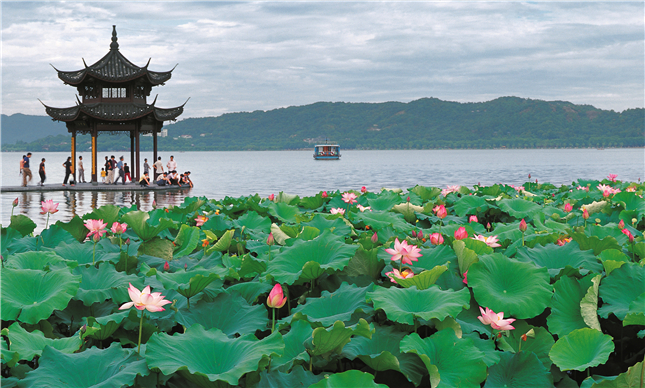Overview

History
One of the birthplaces of Chinese Civilization and ranking among the seven ancient capitals in China, Hangzhou stands out as the "Famous Town of Southeast China". The excavation of the Kuahu Bridge site located in the city's Xiaoshan district indicates that as early as 8,000 years ago the place already saw thriving human activities. The 5,000 year-old Liangzhu culture is hailed by historians as "the dawn of civilization". First set up as a county in the Qin Dynasty (221-206 BC), Liangzhu has a past of over 2,200 years. In the 9th year of Emperor Yang Jian, founder of the Sui Dynasty (581-618), the old Qiantang County (today's Hangzhou) was abolished and replaced by Hangzhou (Hang prefecture), marking the first appearance of its current name. Hangzhou was a marvel to 13th century Italian traveler Marco Polo who called it "the most graceful and splendid city of the world".
Economy
In 2016, Hangzhou achieved a sustainable and stable economic growth. Its gross domestic product (GDP) was 1,105 billion yuan ($170.92 billion), a year-on-year increase of 9.5 percent, ranking first among sub-provincial cities in China. Its GDP was 2.8 percent higher than that of the whole country and 2.0 percent higher than Zhejiang province's. The per capita GDP of its permanent resident population was 121,394 yuan, a year-on-year increase of 7.7 percent.
The city achieved smooth management in financial revenue and expenditure in 2016. The general financial revenue was 255.8 billion yuan, an increase of 14 percent over 2015. Just over 140 billion yuan was general public budget revenue, a rise of 13.2 percent. The general public budget expenditure was 140.4 billion yuan, up by 16.4 percent.
In 2016, the economic aggregate of Hangzhou ranked fourth among provincial capitals in China, behind that of Guangzhou, Chengdu and Wuhan, and ranked fifth among sub-provincial cities and tenth among large and medium-sized cities.
The city was granted the titles of a Top Ten Globally Influential City, a China Top Ten Innovation City, and a China Top Ten Smart City. It is also among the 100 destination cities for international conferences and the 52 tourist destinations considered most worth visiting. The world's first pilot city for sustainable development, Hangzhou was honored as "China happiest city" 13 years in a row.
Culture
Hangzhou boasts a long history and great cultural wealth. Its culture features the landmarks of the city, like West Lake, the Grand Canal and the Qiantang River and embraces integration and development in an open and innovative era.
The West Lake Culture absorbed the essence of local culture in different epochs, such as Kuahuqiao Culture, Liangzhu Culture that dates back to 3310 - 2250 BC, Wuyue Culture, and the cultures of the Southern Dynasty (1127-1279), Ming and Qing dynasties (1368 - 1644, 1644 - 1911) and the Minguo era (1912-1949).
West Lake Culture covers a wide range of elements, including landscape, gardening, religion, architecture, celebrities, folk customs, the Silk Road, tea and cuisine, all coming together in delicacy and harmony.
The Canal Culture, which integrates the specialties, waterscape, local opera and temple fairs, shows the openness, inclusiveness and popularity of Hangzhou Culture.
Qiantangjiang Culture is as magnificent as the tidal bore of the Qiantang River.

